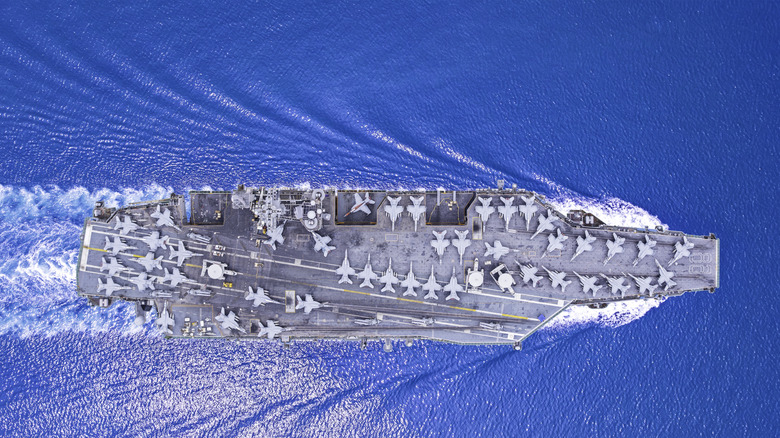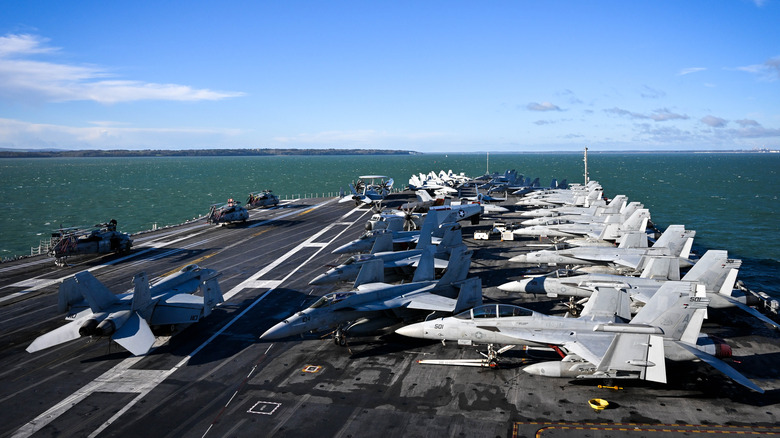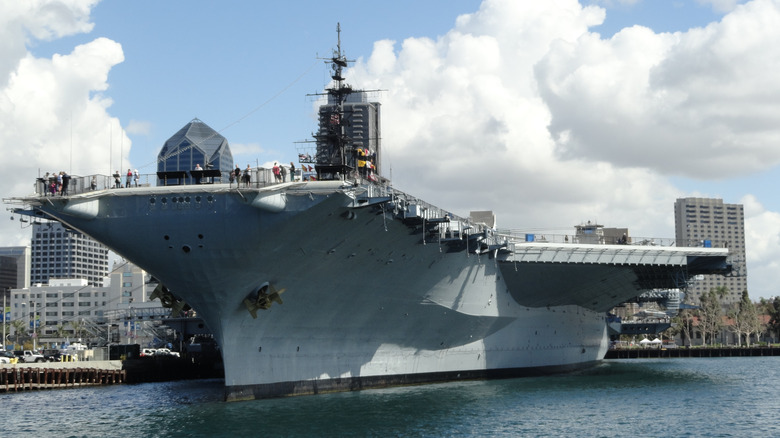How Long Are Aircraft Carrier Runways And Why Are They Angled?
Ever look at a U.S. Navy aircraft carrier and notice that the runway is at an angle? Seems kind of odd. If the carrier used the entirety of the flight deck for one runway, it would be long enough that landing and taking off wouldn't be as challenging as it currently is. As it stands, aviators have a considerably small target to hit when they're landing, which is exceptionally more difficult when the sun is down. The runway itself, after all, is only 300-feet long even on the world's largest aircraft carrier. That is nowhere near the size of an airport runway, but the aircraft aboard a carrier also aren't nearly the same size as a passenger airliner.
Carriers weren't always situated at an angle. Early flight decks were straightaways for planes to takeoff and land. As time went on and aviation evolved, so did carriers and their runways. Eventually, engineers found that the angled runway is simply geometrically superior. The biggest benefit such a runway offers is additional room for aircraft not in use. Older carriers would direct planes that already landed to park at the bow of the ship, shortening the runway with each new row of aircraft. Rear Adm. Dennis Cambell of the British Royal Navy introduced the design for an angled runway, and America adopted the design for its carriers in the 1950s.
There's a bigger benefit to the angled runway
Modern day carriers would be impossible to function without the invention of an angled runway. It allows for carriers to essentially have two runways. One of which pilots can use for taking off while they use the other one for landing. This is especially useful if a landing needs to be called off for whatever reason.
Naval aircraft are built with tailhooks that are designed to snag one of the three arresting wires on the carrier's runway. If the pilot misses catching on the arresting wires, they need to continue in flight and try landing again. If there was a straight runway, there wouldn't be enough space for pilots to retry landing. A fighter jet, like the F/A-18 Super Hornet seen in "Top Gun," would simply crash into any other aircraft parked on the runway.
During the use of propellor planes, all aircraft would takeoff at the same time. Landing wasn't a problem because they were smaller and slower than fighter jets, so there was plenty of room for them on the runway. However, changes needed to happen by the time fighter jets gained prominence. The thought was that larger carriers would be built, but that didn't prove feasible.
The first carriers to use angled runways
As it was a British Admiral who devised the angled flight deck idea, it was the British Royal Navy who got to test it out first. The British painted angled runway lines on the HMS Triumph to test the design. The United States decided to modify the USS Antietam with an extension to test the idea in 1952. Both the American and British Navy were excited about the results.
In 1954, the British added a similar modification to one of its own ships, the HMS Centaur. Shortly after, America went ahead and started adding the new deck design to its Essex-class and Midway-class carriers, but the British beat their allies to the punch. In 1955, the HMS Ark Royal was the first carrier to be built and launched with the new design. America wasn't too far behind, though, as it got its first carrier with the new deck later in the same year on the Forrestal-class carriers. From there on out, America designed all of its carriers with the angled deck.


